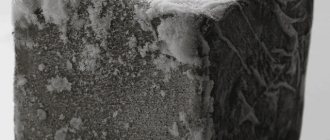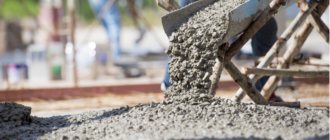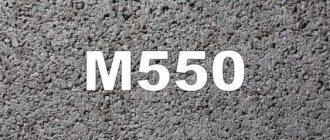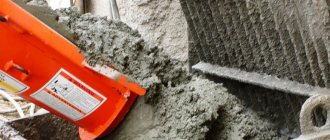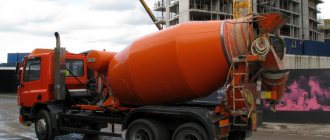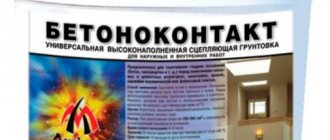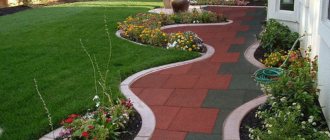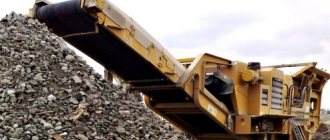The ability of artificial stone not to allow water to pass through under sufficient pressure is called the water resistance of concrete. Designated by the symbol W and within the even numbers from 2 to 20, indicating the pressure in MPa • 10 -1, the concrete elements of which with a height and diameter of 0.15 m hold the onslaught of water and do not allow it to pass through themselves.
Few people think that the use of concrete with high water resistance slightly increases the cost of construction, but can significantly reduce the cost of waterproofing the foundation. Depending on the type of object, it is worth analyzing what is cheaper, buying concrete with a high waterproof rating, or more expensive waterproofing.
What is concrete?
First, let's look at the difference between factory and commercial mixtures. If the concrete mixture was mixed at a factory and then sold at facilities under construction, then such a product is called ready-mixed concrete. The difference between the factory mixture and the regular one is the high quality of the first type. This is confirmed by existing certificates.
How Davidovich geopolymer concrete is used is described in the article.
Taking into account the technical characteristics and properties, concrete has a specific grade or class. These indicators have a direct impact on the strength of the material, but there are certain differences between them.
How internal plastering of aerated concrete walls occurs can be found in this article.
What is the difference between brand and class of concrete? The class assumes a number indicating the guaranteed compressive strength, which is taken to be 0.95. The presented value indicates that the strength indicators established by the class are achieved in 95 cases out of 100.
You can learn about the composition of contact concrete from this article.
Taking into account the strength indicator, the concrete class is designated by the letter B and numbers: B5; B7.5, B10 and so on. The number present in the formula indicates the pressure, expressed in MPa, that the presented product can withstand. For example, B10 is concrete, which in 95% of cases can withstand a pressure of 10 MPa.
What determines the grade of concrete? The grade of concrete requires the presence of letters and symbols: M50, M100, M150, M200 and so on. The number present in the formula indicates the compressive strength. It is obtained by determining the average value based on the test results of samples. The compressive strength is obtained as the arithmetic mean of the 2 largest values in a series of 3 subjects. After the presented measures, a certain value is obtained, expressed in kgf/cm2, which shows the characteristics of the product brand in terms of compressive strength indicators.
You can find out what brand of concrete to use for a strip foundation from this article.
Taking into account construction numbers and rules, when calculating structures made of reinforced concrete and concrete, the documentation indicates not the brand, but the class of the material, however, despite this, most organizations purchase the product in brands. You can read more about floors made of reinforced concrete slabs in the article.
The video talks about marking concrete:
How to use the grade of concrete for the foundation of a two-story house can be found in this article.
Waterproof (W)
Water resistance is the ability of concrete not to allow water to pass under pressure. In this case, the pressure is gradually increased until a certain value is reached, until water begins to leak out.
The water resistance of concrete is marked with the letter W and conventional units (the higher the value, the greater the water resistance). Industrial concrete mixtures have parameters from 2 to 20. Water resistance is one of the important characteristics of concrete, which opens up the possibility of using the mixture outdoors, in underground structures with high groundwater levels, etc. To increase the W value in concrete production, certain chemical additives or special cement (plasticized, etc.). In the building environment, concrete with high water resistance is also called hydraulic concrete.
Characteristics of brands
Today the presented product exists in a wide range. Concrete of a specific brand has its own technical indicators and scope of application. According to strength indicators, concrete can be M50-M800. Minimum numerical values are considered less durable. As a rule, they are used during preparatory activities.
How heavy concrete GOST 26633 2012 is used is indicated in the article.
We determine the technological characteristics for each brand of concrete:
- M100 - used in the production of blind areas, as well as as a basis before reinforcing work. Water absorption level is W2, and frost resistance is F25.
- M200 is concrete, which is used in the construction of structures that require greater strength. Today this brand is considered the most popular and widely in demand. This material is used in the construction of columnar, strip and monolithic foundations. M200 is also used in the production of foundation blocks and floors. Frost resistance for such products is characterized by F100, and water absorption by W4.
- M300 (B22.5) is concrete, which is actively used in the construction of a strip base. Such products have gained wide demand for the production of monolithic walls, floor slabs, stairs, and fences. The degree of frost resistance is F100-F200, but the water absorption level is W6.
- M350 is a product that is used in the production of monolithic foundations, walls, piles, blocks, columns and ceilings. Another material began to be used in the manufacture of reinforced concrete products. The level of frost resistance is F200, and the degree of water absorption is W6
- M450 (B35) - concrete, which is not always convenient to use in construction due to its rapid setting. In addition, such material cannot be considered economically profitable. For this reason, M450 concrete has not gained high popularity in civil engineering. Most often it is used in the construction of dams, subways, and dams. The degree of frost resistance is F300, but the degree of water absorption is W12.
- M500 and M550 . This material has high strength indicators; cement is present in large quantities in the composition of such concrete. Such brands are used in hydraulic engineering construction and in the production of reinforced concrete structures for special purposes.
You can learn how to make a shallow strip foundation for a house made of aerated concrete from this article.
Table 1 - Application of concrete taking into account frost resistance group
| Frost resistance group | Designation | Scope of use |
| Low | less than F50 | Not very popular |
| Moderate | F50 – F150 | The frost resistance and water resistance of the material in this group has optimal characteristics. The presented products are widely used. |
| Increased | F150 – F300 | Due to its high level of frost resistance, such concrete can be used for laying foundations in harsh climates. |
| High | F300 – F500 | This product can be used when laying foundations with variable humidity. |
| Particularly high | over F500 | Such high frost resistance is achieved thanks to the injection method of special additives. Used in the construction of durable structures. |
One of the methods for determining the frost resistance of concrete according to GOST 10060 2012 is to keep it in a freezer at a certain temperature.
Concrete grades for water resistance
The resistance of concrete to water is indicated by the waterproof grade of concrete. The level of stability is directly proportional to the level of the coefficient.
Table 1 Approximate correspondence of concrete grade for water resistance
| Concrete grade | Concrete waterproof class |
| Concrete M100 | W2 |
| Concrete M150 | W2 |
| Concrete M200 | W2 |
| Concrete M250 | W4 |
| Concrete M300 | W4 |
| Concrete M350 | W6 |
| Concrete M400 | W8 |
W2 concrete has high permeability and can absorb a lot of water. It cannot be used without waterproofing. W4 also absorbs a large volume of liquid. Although its performance is higher than W2, it is not recommended to use it without waterproofing.
W6 concrete is a mixture of reduced permeability. Most popular in construction due to the average volume of absorbed moisture.
W8 concrete absorbs only 4.2% by weight. The permeability of the material becomes less subsequently. W20 concrete is the most resistant to water, but in reality it is practically not used.
For the construction of hydraulic structures, water tanks, basement storage facilities or bunkers, grades W10-W20 are used. Waterproofing is not necessary when using these types of concrete. Also, these types of artificial stone have high frost resistance. The material is practically not used for private construction due to the fairly high price (4500 -5300 rubles per 1 m³).
Classification of frost resistance of concrete
Types of concrete mixtures for frost resistance are regulated by GOST 25192-2012. In addition to the F index, frost resistance can be determined by the following characteristics:
- F1 – grade established during the study of material in a water-saturated state;
- F2 is a brand of concrete mixtures produced for the construction of road and airfield pavements or operation in contact with mineralized waters; samples for research are saturated with a 5% NaCl solution.
Requirements for the frost resistance of concrete depend on the planned area of its application:
- Up to F50 . This is a low level of resistance to alternating temperatures. This mixture is used for interior work and in preparatory construction activities.
- F50- F150 . This material with an average level of frost resistance is widely used in ordinary construction of facilities located in regions with a temperate, stable climate.
- F150- F300 . Such concretes are in demand for construction in regions with cold climates.
- Above F300 . Mixtures with high resistance to temperature changes are used for the construction of special-purpose facilities, as well as structures operated in harsh climatic conditions.
The strength and frost resistance of all types of concrete are directly related: the higher the strength, the greater the frost resistance of the material.
Table of dependence of strength class and frost resistance of concrete
Methods for determining the frost resistance of concrete
Methods for determining frost resistance are regulated by GOST 10060-2012. The technique is relevant in the development of new recipes and advanced technologies, quality control during purchase and sale. For testing, a cube-shaped sample with sides of 100-200 mm is made. Freezing and thawing cycles are carried out in the range -18…+18°C. In accordance with GOST, there are several options for calculating this indicator:
- basic multiple;
- accelerated multiple;
- accelerated one-time
If the results of accelerated tests differ from the results of basic tests, then the indicators of basic studies are considered the reference.
The main stages of basic testing of water-saturated samples, carried out in accordance with GOST:
- Concrete cubes are saturated with water and wiped with a damp cloth. Tested for compression.
- The research material is placed in a freezer to be frozen. Maintain the specified mode.
- Thawing is carried out in special baths.
- After thawing, the exfoliated material is removed from the samples with a brush.
- The cubes are wiped with a rag, the mass is determined and tested for compression.
- Process test results.
Reduced frost resistance of a material can be determined using improvised methods. Of course, the results of such studies cannot be used in the preparation of project documentation.
- Visual inspection . Low resistance to alternating temperatures is indicated by the presence of cracks, brown spots, delamination, and peeling.
- Determination of water absorption . If this figure is 5-6%, then resistance to low temperatures will be reduced.
- Drying a moisture-saturated sample in the sun . Its cracking indicates reduced frost resistance.
